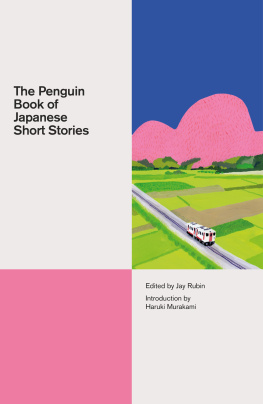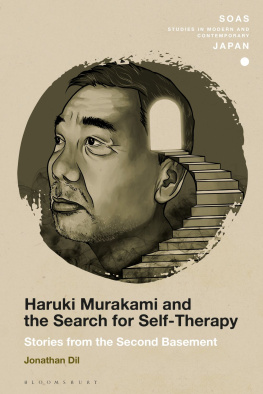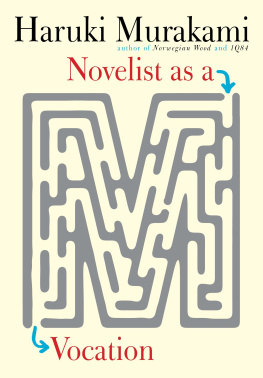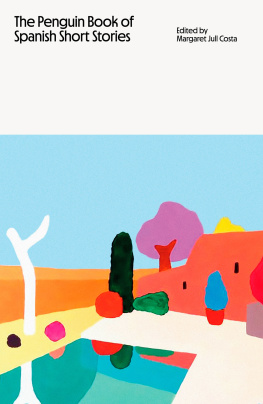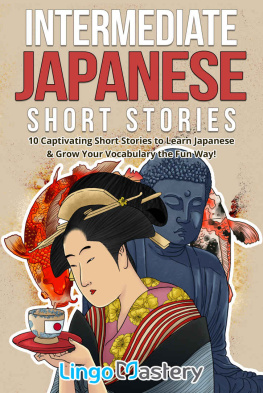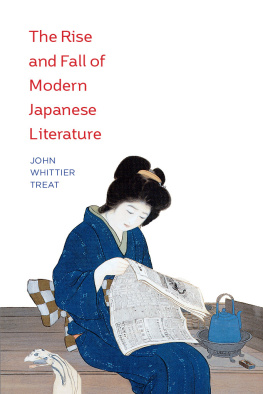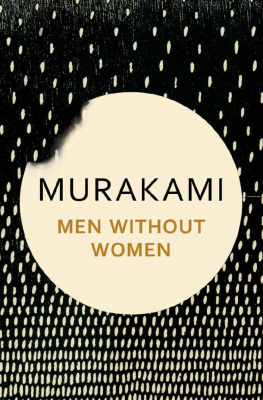Notes
TANIZAKI JUNICHIR
The Story of Tomoda and Matsunaga
. fourth year: Periods of time in this story are calculated using a traditional Japanese reckoning, in which the year of departure and the year of return are both counted as one even though each may be less than a full calendar year in length. Likewise, a child is counted as a year old in the year it is born and takes on another year each New Years Day. Calculated this way, Japanese ages tend to be one or two years higher than when calculated from birthday to birthday.
. pilgrimage to the thirty-three Kannon temples: As a religious austerity, it was customary to visit usually on foot, dressed in white pilgrimage garb with a conical sedge hat and carrying a walking stick thirty-three temples in western Japan enshrining images of Kannon, bodhisattva of compassion.
. waka poetry: The most traditional form of Japanese verse, in five lines of 5-7-5-7-7 syllables.
NAGAI KAF
Behind the Prison
.
.
. O my God with love: Translated from Kafs Japanese. The original runs: mon Dieu, vous mavez bless damour / Et la blessure est encore vibrante, / mon Dieu, vous mavez bless damour Paul Verlaine, Sagesse (1881), II.i.13.
NATSUME SSEKI
Sanshir
. moxibustion: A procedure used in traditional Chinese medicine, as practised in Japan, sometimes performed with acupuncture, wherein bits of the dried moxa plant (Japanese mogusa, or mugwort) are burned on the skin to stimulate the circulation in certain key locations of the body.
. the war: The Russo-Japanese War (19045), fought to determine which of the two imperial powers would dominate parts of Manchuria and Korea, cost Japan over a hundred thousand fighting mens lives as they took such strategic Russian-occupied ports in Manchuria as Port Arthur in Dalian (Dairen in Japanese).
. the poet Shiki: Masaoka Shiki (18671902), the modern haiku master, was a great friend of Ssekis.
MORI GAI
The Last Testament of Okitsu Yagoemon
) and sent in his completed manuscript on 18 September, the day of Nogis funeral. Obsessed with factual accuracy, gai appended a note to his story naming his sources and enumerating the ways in which his fictional version departed from them. He also wrote a more heavily factual version of the story in 1913. See To the reader, dated October 1912, in Mori gai, The Incident at Sakai and Other Stories, ed. David Dilworth and J. Thomas Rimer (Honolulu: University of Hawaii Press, 1977), p. 22. See also pp. 2333 for the 1913 version.
. province of Higo: Higo was a province in central Kyushu, some five hundred miles from Yamashiro (present-day Kyoto).
MISHIMA YUKIO
Patriotism
. Incident of 26 February: The coup staged in 1936 by a group of some hundred young Imperial Japanese Army officers fanatically loyal to the emperor who led nearly fifteen hundred troops in an uprising meant to cleanse the government of perceived foreign-inspired impurities. They succeeded in taking over central Tokyo and assassinating several key government figures, but surrendered by 29 February in the face of united army opposition and the ire of the emperor himself.
NAKAGAMI KENJI
Remaining Flowers
. the alleyway: In the unique fictional world of Nakagami Kenji, those who live in the alleyway are members of Japans outcaste Burakumin, the people of the village historically linked with jobs that were considered defiling or demeaning: leather worker, undertaker, slaughterer, shoemaker. See Eve Zimmerman, Out of the Alleyway: Nakagami Kenji and the Poetics of Outcaste Fiction (Cambridge: Harvard University Press, 2007), pp. 19.
YOSHIMOTO BANANA
Bee Honey
. living under the junta Peronists: During the Dirty War under junta rule in Argentina (197683), established following the overthrow of President Isabel Pron, thousands of students, intellectuals and labour organizers were disappeared. It was after travelling to Argentina that Yoshimoto published the volume containing this story, Adultery and South America, in 2000.
ENCHI FUMIKO
A Bond for Two Lifetimes Gleanings
.
. Tamakazura Prince Genjis love interests: In the eleventh-century Tale of Genji, Genji is attracted to the daughter (by another lover) of a woman he was briefly involved with.
UNO KJI
Closet LLB
. Iwaya Sazanami (18701933): A writer, poet and editor known primarily for his childrens literature.
KAWAKAMI MIEKO
Dreams of Love, Etc.
.)
AKUTAGAWA RYNOSUKE
Hell Screen
.) For an English translation of the much simpler thirteenth-century tale on which this story is based, see D. E. Mills, A Collection of Tales from Uji: A Study and Translation of Uji Shi monogatari (Cambridge: Cambridge University Press, 1970), pp. 1967.
. Chinas First Emperor lofty palaces: Chinas self-proclaimed First Emperor (259210 BC; r. 247210) whose construction of the Great Wall, which began c.228 and was completed a few years after his death, cost the lives of many of his subjects. Yang, the second and last emperor of the Sui dynasty (AD 569618; r. 60418), was another ruler whose ambitious public works cost many lives and much treasure.
. procession of goblins in the Capital: Several eleventh- or twelfth-century stories marked this intersection outside the south-eastern corner of the Imperial Palace grounds as a place where one might encounter a procession of goblins. See, for example, Helen Craig McCullough, kagami: The Great Mirror (Princeton, NJ: Princeton University Press, 1980), p. 136.
. ghost of Tru spirit vanish: For the translation of a Noh play on the legend of Minamoto no Tru (82295), his lavish garden and his ghost, see Kenneth Yasuda, Masterworks of the N Theatre (Bloomington, IN: Indiana University Press, 1989), pp. 46084.
. His Lordship offered buried at the foot of a pillar: This echoes an ancient legend which also inspired a fifteenth-century Noh play, Nagara, in which the spirit of the sacrificial victim returns to seek vengeance for his unjust death.
. Yoshihide: This name has four evenly stressed syllables, pronounced: Yo-shee-hee-deh.
. Monkeyhide: Like Yoshihide, Monkeyhide has four syllables: Mon-key-hee-deh.
. Kawanari or Kanaoka: Both artists, Kose no Kanaoka (fl. c.895) and Kudara no Kawanari (782853), were noted for the uncanny realism of their works, none of which survive. A horse that Kanaoka painted on the Imperial Palace wall was said to escape at night and tear up nearby fields. See Yoshiko K. Dykstra, The Konjaku Tales, 3 vols (Osaka: Intercultural Research Institute, Kansai Gaidai University, 19982003), vol. 2, pp. 2824, for a story about Kawanari.
. Five Levels of Rebirth on the Rygaiji Temple gate, for example: In Buddhism, the five graduated realms to which the dead proceed depending on their virtue in past lives: heaven, human, animal, hungry ghost and hell. Rygaiji is a temple near Nara.

